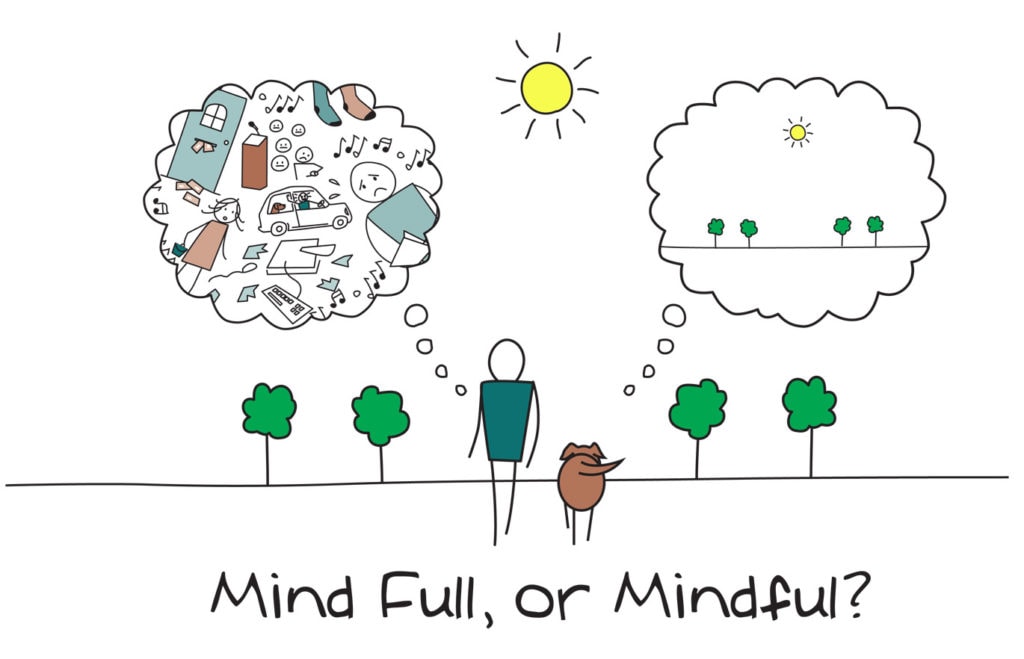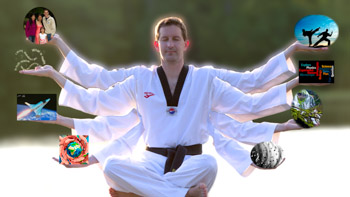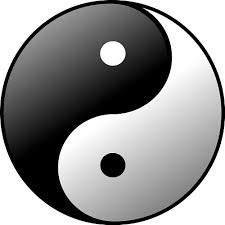What is Mindfulness?
In simplest terms, mindfulness is that state of Being, in which one is deeply and fully present in each moment. Or as the saying goes, “Stopping to smell the roses.” But really……what does that MEAN?

Most People Live Life Deeply Unconscious
How many of these scenarios sound familiar?
- You’ve eaten a meal so fast, you barely remember how it tasted?
- You’re on a long road trip, and you suddenly realize you have no idea when the car in front of you turned off, and you have no idea what you passed in the last 50 miles?
- You’re walking your dogs but thinking of all the different things to do next week?
- You’re watching a movie, texting, browsing Facebook on your laptop, and your significant other has to shake you to get your attention after repeating something 4 times and only getting a mumble in return?
Personally, I’ve experienced every single one of these, and so often I remember stopping and wondering, “What did I miss?” It’s almost like I wasn’t even there – just blew right past anything and everyone around me, completely missing the moment because of being wrapped up in the past or future. Really, it’s almost like being unconscious, isn’t it? Going through life in a blur…..and it often seems like that’s the way most people live.
When You’re Really THERE, and ALIVE!
On the flip side, have you ever stood in the dark of night and looked up at the stars in such awe at their beauty, that all thought simply disappeared, and it was as if nothing else mattered? Or maybe you’ve listened to a piece of music that touched your soul so deeply, it was as if you were immersed in it, and the rest of the world disappeared? Or maybe you were working out so intensely that you could feel every muscle fiber working, every rush of air through your nose and lungs, every drop of sweat as it fell from your forehead? Or soaked in the heat of a hot yoga class and breathed so deeply and calmly that all thought ceased? Those are examples of being fully present, alive, and mindful.
Mindfulness is Not Religious
For my beloved daughters, Natalie and Elizabeth, one important thing to keep in mind: this is not about religion. While the concept of mindfulness is a central one to Buddhism, it is not about Buddhism, or Islam, or Christianity, or anything like that. In fact, you can be a mindful Christian!
Nor does mindfulness mean the same thing as meditation, although absolute mindfulness is an essential goal of meditation. And as I live in the South of the USA, otherwise known as the “Bible Belt,” where conservative Christianity is a powerful influence, I’d like to remind readers that meditation itself is not necessarily a religious act, and that people of ALL religions can find meditation to be helpful in their spiritual journey.
Mindfulness in the Martial Arts
I recently wrote about my training in the martial arts, with an introduction to my training in Shaolin Kung Fu at The Peaceful Dragon in Charlotte, NC. It was during the preparation for my 1st Dan (black belt) test in Taekwondo that I was first exposed to the idea of mindfulness in Living Buddha, Living Christ by Thich Naht Han. The following quote was one of the first that I underlined and highlighted in the book, as I find it a perfect summary:
In Buddhism, our effort is to practice mindfulness in each moment – to know what is going on within and all around us. When the Buddha was asked, “Sir, what do you and your monks practice?” he replied, “We sit, we walk, and we eat.” The questioner continued, “But sir, everyone sits, walks, and eats,” and the Buddha told him, “When we sit, we know we are sitting. When we walk, we know we are walking. When we eat, we know we are eating.” Most of the time, we are lost in the past or carried away by future projects and concerns. When we are mindful, touching deeply the present moment, we can see and listen deeply, and the fruits are always understanding, acceptance, love, and the desire to relieve suffering and bring joy. When our beautiful child comes up to us and smiles, we are completely there for her.
No Matter What You’re Doing, Simply Do It….and Nothing Else
In our crazy, hectic, technology-driven, media-overloaded, 1,000-TV-channels-to-watch-but-nothing-good-is-on, consumerist-gotta-buy-more-need-more-work-harder-to-get-more Western society, we usually hear nothing but “how to get more done in less time!” And certainly, technology has allowed us to do far more in the same 24-hour days that we’ve always had. And yet…..have you ever noticed that you really can’t multi-task? The more you try to do at once, the less well you do anything.
 Admittedly, as a person living with ADD, this can be a real struggle! Even if I don’t want to do anything but the task on which I’m working, my brain is conspiring against me. Not that this is limited to ADD – most everyone is easily distracted to one degree or the other; it’s just that people with ADD/ADHD have even more difficulty. This image is supposed to show how I balance my varied interests in equanimity and peace; it equally well could show me struggling to juggle all of them!
Admittedly, as a person living with ADD, this can be a real struggle! Even if I don’t want to do anything but the task on which I’m working, my brain is conspiring against me. Not that this is limited to ADD – most everyone is easily distracted to one degree or the other; it’s just that people with ADD/ADHD have even more difficulty. This image is supposed to show how I balance my varied interests in equanimity and peace; it equally well could show me struggling to juggle all of them!
(Incidentally, I’ve been fascinated recently by how well this image really represents my life. Regardless of the topic on which I’m writing, somehow it seems to fit.)
The Struggle for Balance, or Walking the Blade’s Edge
In Karen Armstong’s book, Buddha, she relates how Gotama believed that a lay person could never truly reach enlightenment, because there are too many distractions. This was not a bad thing; it simply was how it was for those who played those roles. However, lay people could travel down the path towards enlightenment by practicing mindfulness, the Fourfold Path, etc, and this was good enough to hopefully put them into a better life the next time around. Personally, I don’t believe in reincarnation, and I don’t plan on abandoning my life to become a monk, so I just do the best I can for now, because I basically agree with Buddha on that point.
 Since I began practicing mindfulness, meditation, mental visualizations for success, and learning how to be financially successful in business, it has been my experience that it is quite difficult to practice both at the same time. To focus powerfully on what must be done for financial/business success, it requires a tremendous outward focus on plans for the future, evaluation of past performance, determining what to do right now, etc. Being mindful during this process has been a challenge for me. Alternately, when I am allowing myself plenty of time to meditate, practice yoga, focus on each moment, it becomes extraordinarily difficult to keep the focus on working as hard as necessary.
Since I began practicing mindfulness, meditation, mental visualizations for success, and learning how to be financially successful in business, it has been my experience that it is quite difficult to practice both at the same time. To focus powerfully on what must be done for financial/business success, it requires a tremendous outward focus on plans for the future, evaluation of past performance, determining what to do right now, etc. Being mindful during this process has been a challenge for me. Alternately, when I am allowing myself plenty of time to meditate, practice yoga, focus on each moment, it becomes extraordinarily difficult to keep the focus on working as hard as necessary.
I’ve recently come to accept that this is OK. Like the symbol of Yin and Yang, coming and going, doing and not-doing, thinking and just-being, as one who seeks both peace and success (I like to have my cake and eat it, too! Thanks to T. Harv Eker and Secrets of the Millionaire Mind for teaching me that one), I’ve learned that life is full of ebbs and flows, just like the tide, and to flow with it.
The “Now” is All There Is
In most Western cultures, there’s this incredible focus on “not enough time to do everything.” We’re so focused on “making time,” “what time do I have to be there,” “we’re going to be late!” and “I need more hours in the day,” that we never consider this very simple fact:
You can not do or be ANYTHING at ANY TIME except NOW.
Eckhart Tolle’s profound book, The Power of Now, had a powerful and transformative effect on my life about 7 years ago (that would be early 2007). In my opinion, Tolle is a modern incarnation of the Buddha for the Western world. He uses language that is understandable to our mindset, and analogies that ring familiar more than the ancient stories of Buddha. Tolle takes practical examples from modern life and demonstrates how to be more self-aware, more present, and more mindful during each situation. He helps us understand that our identity is NOT who we really are, because that identity is constantly changing. The ego is nothing more than a momentary representation of who we are, with no permanent meaning. And as one learns to release the clinging need to hold on to that fleeting identity, one recognizes the fleeting reality of life as it passes by, bringing us to a more mindful awareness that only the present really exists.
Where and When Are You?
In another of Thich Naht Han’s books, which I recently read as part of a monthly assignment for The Peaceful Dragon, he relates this story as another example:
While washing the dishes one should only be washing the dishes, which means that while washing the dishes one should be completely aware of the fact that one is washing the dishes.
Hanh, Thich Nhat (1996-04-05). The Miracle of Mindfulness: An Introduction to the Practice of Meditation (p. 6). Beacon Press. Kindle Edition.
As you go through each day, may I simply encourage each of you, dear Readers, to be mindful and present in each and every thing you do. Breathe deeply – look deeply – know where you are and what you’re doing fully – simply BE: wherever, whoever, and whenever you are…..and not anywhere or anyone or any time else. 🙂